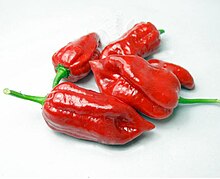| Habanaga pepper | |
|---|---|
 | |
| Heat |
|
| Scoville scale | 500,000-800,000 [1] SHU |
The Habanaga is a cultivar of the chili pepper Capsicum chinense. This pepper was developed in New Mexico when a university student unintentionally crossed a Habanero and a Bhut Jolokia. [2][ when?]
Has a heat level of 800,000 Scoville Units.[ by whom?] If the Habanaga is too hot for a dish, a Habanero pepper can be used as a substitute
| Nutritional value per 100 g (3.5 oz) | |
|---|---|
4 g of carbohydrates. | |
1 g of protein | |
| †Percentages estimated using US recommendations for adults, [3] except for potassium, which is estimated based on expert recommendation from the National Academies. [4] | |
- ^ "How Hot Are Chile Peppers?".
- ^ "Habanaga Pepper".
- ^ United States Food and Drug Administration (2024). "Daily Value on the Nutrition and Supplement Facts Labels". FDA. Archived from the original on 2024-03-27. Retrieved 2024-03-28.
- ^ National Academies of Sciences, Engineering, and Medicine; Health and Medicine Division; Food and Nutrition Board; Committee to Review the Dietary Reference Intakes for Sodium and Potassium (2019). Oria, Maria; Harrison, Meghan; Stallings, Virginia A. (eds.). Dietary Reference Intakes for Sodium and Potassium. The National Academies Collection: Reports funded by National Institutes of Health. Washington, DC: National Academies Press (US). ISBN 978-0-309-48834-1. PMID 30844154. Archived from the original on 2024-05-09. Retrieved 2024-06-21.
| Habanaga pepper | |
|---|---|
 | |
| Heat |
|
| Scoville scale | 500,000-800,000 [1] SHU |
The Habanaga is a cultivar of the chili pepper Capsicum chinense. This pepper was developed in New Mexico when a university student unintentionally crossed a Habanero and a Bhut Jolokia. [2][ when?]
Has a heat level of 800,000 Scoville Units.[ by whom?] If the Habanaga is too hot for a dish, a Habanero pepper can be used as a substitute
| Nutritional value per 100 g (3.5 oz) | |
|---|---|
4 g of carbohydrates. | |
1 g of protein | |
| †Percentages estimated using US recommendations for adults, [3] except for potassium, which is estimated based on expert recommendation from the National Academies. [4] | |
- ^ "How Hot Are Chile Peppers?".
- ^ "Habanaga Pepper".
- ^ United States Food and Drug Administration (2024). "Daily Value on the Nutrition and Supplement Facts Labels". FDA. Archived from the original on 2024-03-27. Retrieved 2024-03-28.
- ^ National Academies of Sciences, Engineering, and Medicine; Health and Medicine Division; Food and Nutrition Board; Committee to Review the Dietary Reference Intakes for Sodium and Potassium (2019). Oria, Maria; Harrison, Meghan; Stallings, Virginia A. (eds.). Dietary Reference Intakes for Sodium and Potassium. The National Academies Collection: Reports funded by National Institutes of Health. Washington, DC: National Academies Press (US). ISBN 978-0-309-48834-1. PMID 30844154. Archived from the original on 2024-05-09. Retrieved 2024-06-21.